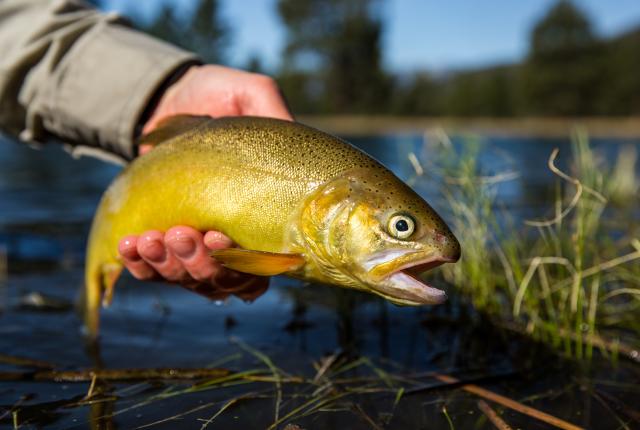A SILVERY FLASH in the narrow Whitewater Creek pool meant that I was close. But the shadowy fish disappeared along the rocky canyon wall just as quickly. The tight quarters under the Catwalk National Recreation Trail left no room to cast, so I just dropped my flies at the top of the pool and let them drift through the deepest part. Nothing.
On the second try, I floated the nymphs closer to the edge, and the indicator paused ever so slightly. Boom! I set the hook—and the fish ran to the end of the pool, breaking the surface with a shake of its entire body. Once the tiny fish was safely cradled in my net, it was easy to see the distinctive golden-yellow body and dark spotting of a Gila trout. I took a quick photo and back into the water it went.
Over the past two years of fly-fishing, I’d caught my share of rainbows, browns, and Río Grande cutthroats, but this was my first Gila trout. A relative of the Pacific salmon, the native species had been on the brink of extinction by the 1950s. Habitat loss, overfishing, and pressure from non-native species limited the population to just five streams in the Gila and Aldo Leopold wilderness areas. Thanks to considerable efforts from state and federal agencies, the reach of the Gila trout has since been expanded, allowing for the kind of fishing I and many others enjoy.
That first catch propelled me another mile up the trail for a few hundred more casts, resulting in just two more fish. But as I held each one briefly in my hand, the sunlight set their golden sides ablaze and I let them slip back into the stream.
It’s the kind of moment that makes New Mexico special and makes me thankful that Aldo Leopold and others had the foresight to preserve the wild places where Gila trout, elk, mountain lions, Mexican gray wolves, black bears, and coati can be found. In fact, the 558,000 acres of the Gila are home to some 35 endangered, threatened, and sensitive species.
In this month’s “Where the Wild Things Are,” we celebrate the Land of Enchantment’s rich biodiversity and some of the early scientists who helped us to better understand and preserve it. We’re also lucky to share three intimate portraits from Randal Ford’s book, Animal Kingdom, including our cover image of Red Cloud the bison. This issue and these intimate images are important because holding a Gila trout in your hand, witnessing sandhill cranes landing at Bosque del Apache Wildlife Refuge, or looking into a bison’s eyes helps us to realize our connection to all things big and small.



